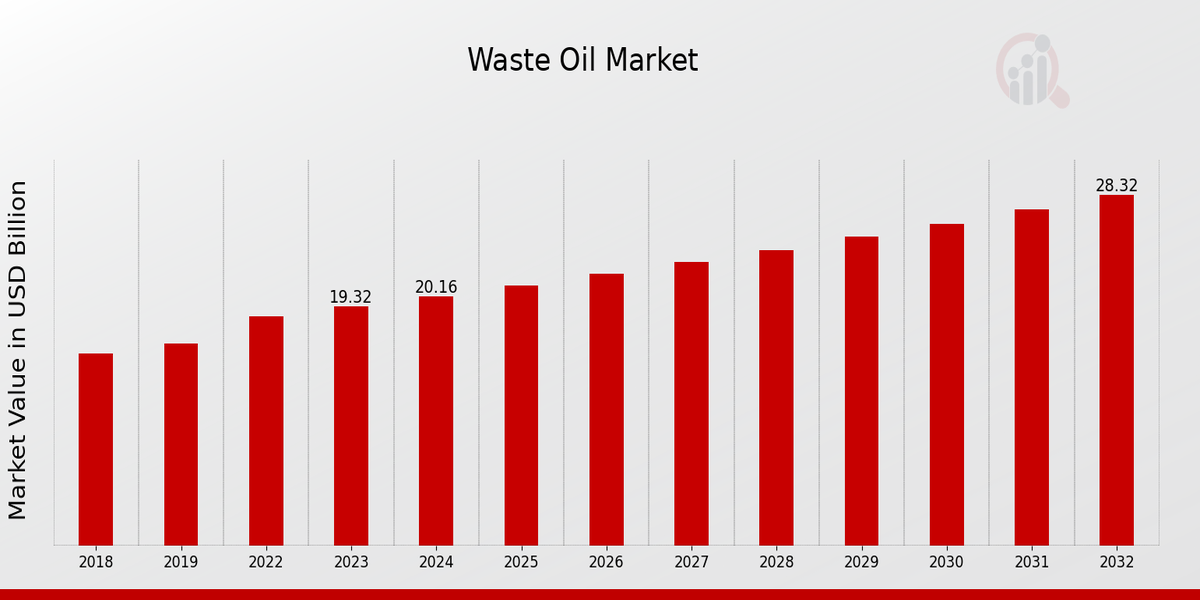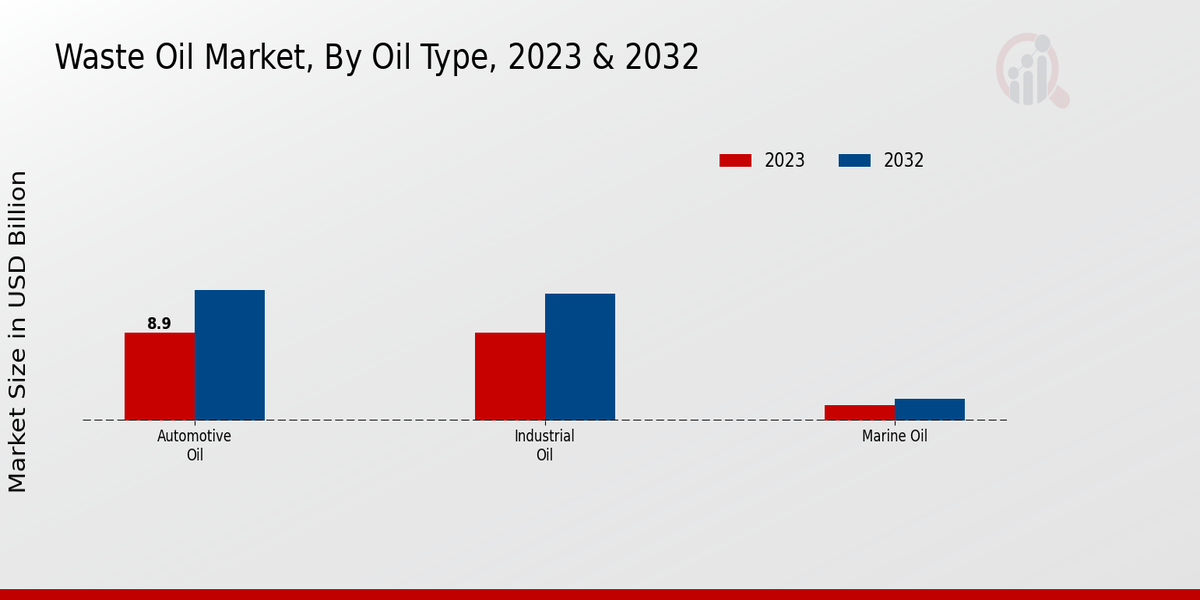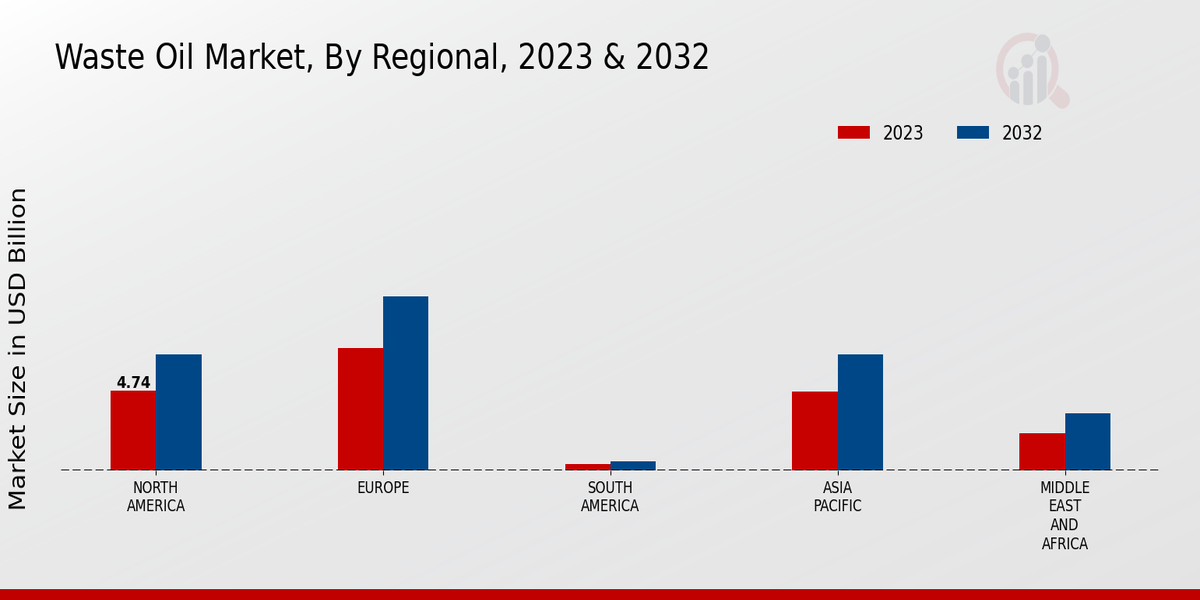Global Waste Oil Market Overview
The Waste Oil Market Size was estimated at 21.04(USD Billion) in 2024. The Waste Oil Industry is expected to grow from 21.95(USD Billion) in 2025 to 32.18(USD Billion) by 2034. The Waste Oil Market CAGR (growth rate) is expected to be around 4.30% during the forecast period (2025 - 2034).
Key Waste Oil Market Trends Highlighted
The waste oil market is experiencing several notable trends that are shaping its dynamics. Key market drivers include increasing industrialization, surging demand for processed waste oil derivatives, and stringent environmental regulations. These factors are driving the adoption of advanced waste oil management practices, fostering research and development in oil recycling technologies, and promoting the use of waste oil as an alternative fuel source.Opportunities for market growth lie in the exploration of emerging technologies capable of efficiently recycling waste oil and extracting valuable resources, as well as the capturing of untapped markets in developing economies where waste oil management infrastructure is still nascent. In recent times, the market has witnessed a surge in the adoption of waste oil-to-energy conversion technologies, such as pyrolysis and gasification, offering eco-friendly and cost-effective solutions for waste disposal.Moreover, collaborations between market players and government agencies are facilitating the implementation of comprehensive waste oil management systems, which is further bolstering the industry's growth prospects.
Source: Primary Research, Secondary Research, MRFR Database and Analyst Review
Waste Oil Market Drivers
Increasing Environmental Regulations
Stringent environmental regulations imposed by governments worldwide are driving the growth of the Waste Oil Market Industry. Governments are implementing policies and standards to reduce the environmental impact of waste oil disposal. These regulations mandate proper waste oil management practices, including collection, transportation, and recycling. As a result, businesses and industries are increasingly seeking cost-effective and environmentally friendly waste oil disposal solutions, contributing to the demand for waste oil recycling and treatment services.
Growing Industrialization and Urbanization
The significant factor that is boosting the growth in the Waste Oil Market Industry is rapid industrial and urban development. Developing manufacturing and transportation industries, which tend to use more oil, eventually increase the amount of waste oil. Rapid urbanization is another factor that increases the volume of waste oil. As the population in an urban area increases, the number of vehicle owners also goes up, leading to the production of more waste oil.Due to these major reasons, there is growing pressure to have more waste oil management and processing facilities in place.
Technological Advancements
Advancements in technology are revolutionizing the Waste Oil Market Industry. The development of innovative waste oil treatment and recycling technologies has improved the efficiency and cost-effectiveness of waste oil management processes. These technologies enable the recovery of valuable resources from waste oil, such as base oils and fuels, reducing waste and promoting sustainability.
Waste Oil Market Segment Insights
Waste Oil Market Oil Type Insights
The Waste Oil Market is segmented by oil type into automotive oil, industrial oil, marine oil, and other oils. Among these segments, automotive oil held the largest market share in 2023, accounting for nearly half of the waste oil market revenue. The dominance of automotive oil can be attributed to the large volume of waste oil generated from vehicles worldwide. As per industry estimates, approximately 1 billion tons of waste oil is produced annually, with a significant portion originating from automotive sources. The growth of the automotive industry, particularly in emerging economies, is expected to further drive the demand for automotive oil.In terms of market growth, industrial oil is projected to witness the highest CAGR during the forecast period. This growth is attributed to the increasing use of industrial oils in various sectors, including manufacturing, mining, and construction. The demand for industrial oil is driven by its ability to enhance machinery performance and extend equipment life. The growing focus on industrial automation and the expansion of manufacturing industries are expected to contribute to the growth of the industrial oil segment in the coming years. Marine oil, which comprises waste oil generated from marine vessels, is another significant segment of the waste oil market.Stringent environmental regulations regarding the disposal of waste oil from ships and offshore platforms have led to increased demand for proper waste oil management solutions. The adoption of eco-friendly practices in the maritime industry is expected to drive the growth of the marine oil segment in the future. Other oils, which include waste oils from various sources such as food processing, pharmaceuticals, and household cooking, represent a relatively smaller segment of the waste oil market. However, this segment is expected to grow steadily over the forecast period due to increasing awareness about proper waste oil disposal and the development of innovative recycling technologies. 
Source: Primary Research, Secondary Research, MRFR Database and Analyst Review
Waste Oil Market End-Use Industry Insights
One of the most crucial factors that determine the nature of the Waste Oil Market is the End-Use Industry segment. Among major end-use industries, it is the Transportation industry that can be characterized as the leading one as the segment yields a significant portion of the Waste Oil Market revenue. The growing demand for transportation is the primary factor contributing to this growth as although the increasing number of vehicles results in high pollutant emission levels, new and rather strict regulations motivate people to develop new trends in the industry.The Manufacturing industry, in turn, also holds a rather significant share in the market as there are numerous industrial processes characterized by the substantial amount of oil used, which results in waste oil that needs to be disposed of and treated. Mining and Construction industries are other significant contributors to the development of the Waste Oil Market, as both areas are characterized by the usage of heavy industrial machinery and equipment that cannot function without utilizing oil. Furthermore, Other Industries, including agriculture, healthcare, and energy, also contribute to the overall Waste Oil Market.Undoubtedly, the specified segmentation is of utmost importance for waste oil creating and management companies and other relevant manufacturers and service providers, as it helps assess needs of every separate end use industry and custom their offerings. Moreover, companies should also consider the nature of their operations and current market dynamics and trends to benefit from the increased potential for growth in the Waste Oil Market and develop a competitive advantage.
Waste Oil Market Treatment Method Insights
The Waste Oil Market is segmented by Treatment Method into Landfilling, Incineration, Recycling, Reuse, and Other Methods. Landfilling is the most widely used method, accounting for over 50% of the market share in 2023. However, due to growing environmental concerns and stringent regulations, the market for sustainable treatment methods such as Recycling and Reuse is expected to witness significant growth in the coming years. The Recycling segment is projected to grow at a CAGR of 6.2% from 2024 to 2032, owing to the increasing adoption of advanced technologies for waste oil re-refining and the rising demand for recycled lubricants.The Reuse segment is also expected to exhibit a steady growth rate during the forecast period, driven by the growing use of waste oil as a fuel substitute in various industries.
Waste Oil Market Process Insights
The Waste Oil Market is segmented by Process into Hydrotreating, Distillation, Pyrolysis, Gasification, and Other Processes. In 2023, the Hydrotreating segment accounted for the largest share of the market, valued at 4.32 USD billion. The Distillation segment is expected to grow at the highest CAGR of 4.75% during the forecast period 2023-2032. The Pyrolysis segment is expected to reach a valuation of 5.34 USD billion by 2032. The Gasification segment is projected to grow steadily over the forecast period, with a CAGR of 4.23%. The Other Processes segment includes processes such as solvent extraction, vacuum distillation, and chemical treatment and is expected to account for a significant share of the market throughout the forecast period.
Waste Oil Market Regional Insights
The regional segmentation of the Waste Oil Market offers valuable insights into the market's geographical distribution and growth dynamics. In 2023, North America held the largest market share, accounting for approximately 35% of the Waste Oil Market revenue. The region's stringent environmental regulations and well-established waste management infrastructure contribute to this dominance. Europe follows closely, with a market share of around 30%, driven by similar environmental concerns and advanced waste oil recycling technologies.The APAC region is projected to witness the highest growth rate during the forecast period, owing to rapid industrialization and increasing awareness of waste oil management. South America and MEA hold relatively smaller market shares but are expected to experience steady growth in the coming years.
Source: Primary Research, Secondary Research, MRFR Database and Analyst Review
Waste Oil Market Key Players And Competitive Insights
Key players in the Waste Oil Market are always trying to gain a competitive advantage by investing in research and development, expanding their product portfolio and partnering with other companies. Examples of key players in the industry include Neste, Eni, Repsol, TotalEnergies, and Valero Energy Corporation. These firms are trying to enhance the efficiency of their waste oil recycling and refining processes by investing in the development of innovative technological solutions. The Waste Oil Market industry is very competitive, and major players are using different strategies to increase their respective market shares.Nestle is a major player in the Waste Oil Market industry that focuses on sustainable development and innovation. For this reason, the company has invested in research and development to enhance the efficiency of its waste oil recycling and refining processes. Additionally, Neste has expanded its product portfolio to offer a wider range of waste oil-based products, such as biofuels and waste-oil-based lubricants. On the other hand, Repsol is developing new recycling technologies to efficiently recycle waste oil and promote a circular economy. The company focuses on the development of innovative waste oil-based products, such as chemicals and bioplastics, to solve various environmental problems and reduce waste generation.
Key Companies in the Waste Oil Market Include
-
Phillips 66
-
Neste
-
Suez
-
CEPSA
-
Galp
-
TotalEnergies
-
Valero Energy
-
NextChem
-
Technip FMC
-
ExxonMobil
-
Repsol
-
Veolia
-
Marathon Petroleum
-
Chevron
-
Eni
Waste Oil Market Industry Developments
The Waste Oil Market is poised to reach a valuation of USD 28.3 billion by 2032, exhibiting a CAGR of 4.34% from 2024 to 2032. Increasing environmental concerns and government regulations regarding waste management, coupled with the growing demand for sustainable practices, are driving market expansion. The market is witnessing advancements in waste oil collection and recycling technologies, with companies investing in research and development to enhance efficiency and reduce environmental impact. Key industry players are collaborating with governments and organizations to promote waste oil management initiatives and raise awareness among consumers. The market is expected to benefit from the growing popularity of bio-based lubricants and the increasing adoption of electric vehicles, which generate less waste oil.
Waste Oil Market Segmentation Insights
Waste Oil Market Oil Type Outlook
-
Automotive Oil
-
Industrial Oil
-
Marine Oil
-
Other Oils
Waste Oil Market End-Use Industry Outlook
-
Transportation
-
Manufacturing
-
Mining
-
Construction
-
Other Industries
Waste Oil Market Treatment Method Outlook
-
Landfilling
-
Incineration
-
Recycling
-
Reuse
-
Other Methods
Waste Oil Market Process Outlook
-
Hydrotreating
-
Distillation
-
Pyrolysis
-
Gasification
-
Other Processes
Waste Oil Market Regional Outlook
-
North America
-
Europe
-
South America
-
Asia Pacific
-
Middle East and Africa
| Report Attribute/Metric |
Details |
| Market Size 2024 |
21.04(USD Billion) |
| Market Size 2025 |
21.95(USD Billion) |
| Market Size 2034 |
32.18(USD Billion) |
| Compound Annual Growth Rate (CAGR) |
4.30% (2025 - 2034) |
| Report Coverage |
Revenue Forecast, Competitive Landscape, Growth Factors, and Trends |
| Base Year |
2024 |
| Market Forecast Period |
2025 - 2034 |
| Historical Data |
2020 - 2024 |
| Market Forecast Units |
USD Billion |
| Key Companies Profiled |
Phillips 66, Neste, Suez, CEPSA, Galp, TotalEnergies, Valero Energy, NextChem, Technip FMC, ExxonMobil, Repsol, Veolia, Marathon Petroleum, Chevron, Eni |
| Segments Covered |
Oil Type, End-Use Industry, Treatment Method, Process, Regional |
| Key Market Opportunities |
Biodiesel Production, Refining, Energy Generation, Lubricant Production, Waste Oil Collection and Transportation |
| Key Market Dynamics |
Increasing Industrialization, Government Initiatives, Technological Advancements, Rising Environmental Awareness, Growing Production of Base Oils |
| Countries Covered |
North America, Europe, APAC, South America, MEA |
Frequently Asked Questions (FAQ) :
The waste oil market is expected to reach a valuation of USD 21.04 billion by 2034, exhibiting a CAGR of 4.30% during the forecast period (2025-2034).
North America held the largest market share in 2023 and is expected to maintain its dominance throughout the forecast period.
The use of waste oil as a fuel in various industries, including cement manufacturing, power generation, and steel production, contributes significantly to the overall market growth. The demand for waste oil as a fuel substitute is expected to continue growing due to its cost-effectiveness and environmental benefits.
Some of the prominent players in the waste oil market include Safety-Kleen Systems, Inc., Veolia Environmental Services, Clean Harbors, Inc., and Waste Management, Inc. These companies offer a range of waste oil collection, recycling, and disposal services to cater to the diverse needs of various industries.
The increasing adoption of sustainable waste management practices and the growing awareness of the environmental impact of waste oil disposal are driving the growth of the waste oil market. Governments worldwide are implementing stringent regulations to encourage the proper collection and recycling of waste oil, further fueling market expansion.
The waste oil market is anticipated to exhibit a steady growth rate of 4.34% CAGR during the forecast period (2024-2032), owing to the increasing demand for waste oil as a sustainable and cost-effective fuel alternative.
The waste oil market faces challenges related to the illegal dumping and improper disposal of waste oil, which can lead to environmental contamination. Additionally, the fluctuating prices of crude oil can impact the demand for waste oil as a fuel substitute.
Government regulations play a crucial role in shaping the waste oil market. Many countries have enacted laws and regulations to ensure the proper management and disposal of waste oil. These regulations aim to minimize environmental pollution and promote the reuse and recycling of waste oil.
Stakeholders in the waste oil market can capitalize on the growth opportunities by investing in innovative waste oil collection and recycling technologies. Additionally, partnerships with waste generators and end-users can help create a sustainable and efficient waste oil management system.
The future of the waste oil market looks promising, driven by the increasing adoption of circular economy principles and the growing demand for sustainable waste management solutions. Technological advancements and government initiatives are expected to further support the growth of the market in the coming years.

















